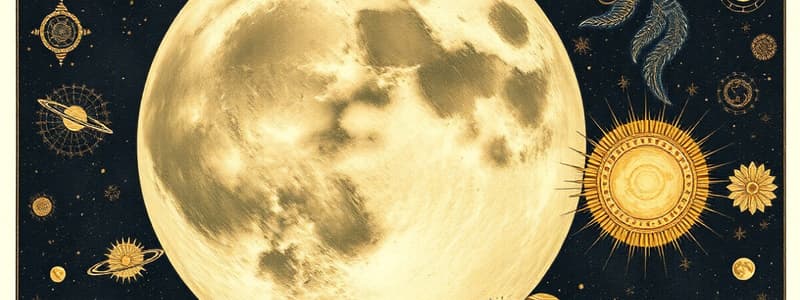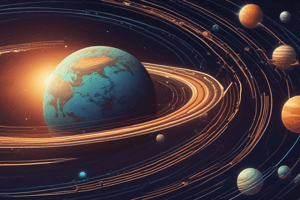Podcast
Questions and Answers
What is the primary reason the Moon cannot support life as we know it?
What is the primary reason the Moon cannot support life as we know it?
- The Moon's surface is too cold.
- The Moon is too far from the Sun.
- The Moon has a very thin and weak atmosphere and lacks liquid water. (correct)
- The Moon does not generate its own light.
Why do astronauts appear to bounce on the Moon's surface?
Why do astronauts appear to bounce on the Moon's surface?
- The Moon's atmosphere creates an upward force.
- Astronauts wear special boots that help them bounce.
- The Moon's gravity is about one-sixth of Earth's gravity. (correct)
- The Moon has a solid, rocky surface.
Which of the following best describes the lunar regolith?
Which of the following best describes the lunar regolith?
- A dense layer of volcanic rock.
- A layer of frozen water ice found in craters.
- A smooth, reflective surface that covers the Moon.
- A rubble pile of charcoal-gray, powdery dust and rocky debris. (correct)
Why does the same side of the Moon always face Earth?
Why does the same side of the Moon always face Earth?
How was water confirmed to exist on the sunlit surface of the Moon?
How was water confirmed to exist on the sunlit surface of the Moon?
The Moon is believed to have formed as a result of...
The Moon is believed to have formed as a result of...
Which statement accurately describes the volcanic activity on the Moon?
Which statement accurately describes the volcanic activity on the Moon?
Considering that the Moon makes Earth a more livable planet, which effect contributes the most?
Considering that the Moon makes Earth a more livable planet, which effect contributes the most?
What is the 'far side' of the Moon?
What is the 'far side' of the Moon?
In the context of the solar system, how does the size of the Moon compare to other moons?
In the context of the solar system, how does the size of the Moon compare to other moons?
What is the approximate duration of the Moon's orbit around the Earth as observed from Earth?
What is the approximate duration of the Moon's orbit around the Earth as observed from Earth?
What is the exosphere?
What is the exosphere?
What is the name of the crater where the water molecule was detected?
What is the name of the crater where the water molecule was detected?
The Moon reflects light from the sun. Is this reflection constant?
The Moon reflects light from the sun. Is this reflection constant?
What is the Earth's Moon named in Latin?
What is the Earth's Moon named in Latin?
What best describes the effect of Earth and Moon rotating?
What best describes the effect of Earth and Moon rotating?
What are the surface features on the moon caused by?
What are the surface features on the moon caused by?
Which of the following occurred first?
Which of the following occurred first?
The moon's gravity is $\frac{1}{6}$ of the Earth's. What is the difference most noticeable in?
The moon's gravity is $\frac{1}{6}$ of the Earth's. What is the difference most noticeable in?
The Moon's orbit and rotation are key to life on Earth. Which of the following is affected?
The Moon's orbit and rotation are key to life on Earth. Which of the following is affected?
Flashcards
What is the Moon?
What is the Moon?
The only place beyond Earth where humans have set foot.
Physical characteristics of the Moon?
Physical characteristics of the Moon?
The 5th largest moon among the 200+ moons orbiting in our solar system. It has a solid, rocky surface with craters and a very thin atmosphere called an exosphere that is not breathable and cannot support life.
Moon's effect on Earth?
Moon's effect on Earth?
The moon makes Earth a more livable planet by moderating our home planet's wobble on its axis, leading to a relatively stable climate.
How did the Moon form?
How did the Moon form?
Signup and view all the flashcards
Moon's structure?
Moon's structure?
Signup and view all the flashcards
What is lunar regolith?
What is lunar regolith?
Signup and view all the flashcards
What is the Moon's gravity?
What is the Moon's gravity?
Signup and view all the flashcards
Synchronous rotation
Synchronous rotation
Signup and view all the flashcards
What is the 'far side' of the moon?
What is the 'far side' of the moon?
Signup and view all the flashcards
Moon's orbit around Earth?
Moon's orbit around Earth?
Signup and view all the flashcards
Evidence of water on the Moon?
Evidence of water on the Moon?
Signup and view all the flashcards
Study Notes
- Luna, Latin for Moon, is the only place beyond Earth that humans have stepped foot on
- The Moon ranks as the 5th largest out of over 200 moons in our solar system
- Its surface is solid and rocky, marked by craters and hollows caused by asteroid, meteorite, and comet impacts
- The Moon's exosphere is too thin to be breathable
- The moon does not emit its own light, instead it reflects the light of the sun
- The Moon is the brightest and largest object in Earth's night sky
- It helps stabilize Earth’s climate, by moderating its axial wobble
Moon Formation
- Scientists theorize that the Moon was formed early in the solar system's history
- This was caused when Earth collided with a Mars-sized object
- The impact scattered debris from both Earth and the other object into space
- Gravity then pulled the debris together to form the Moon
Moon Structure
- The Moon has a core, mantle, and crust
- The Moon used to have active volcanoes, but are now dormant
Moon Surface
- Over billions of years, impacts have broken down the Moon’s surface into fragments ranging from large boulders to fine powder
- The lunar regolith is a layer of charcoal-gray, powdery dust, and rocky debris covering nearly the entire Moon
Moon Gravity
- The Moon's surface gravity is about one-sixth of Earth's
- The lower gravity causes moonwalking astronauts to appear as if they are bouncing
Moon Rotation and Orbit
- The moon is in synchronous rotation where its rotation matches its orbit
- The same side of the Moon always faces Earth
- The side of the moon we don't see is called the "far side"
- The Moon completes an orbit around Earth in 27 Earth days
- The Moon seems to orbit Earth every 29 days from our viewpoint, after taking into account Earth's rotation around the sun
Water on the Moon
- In October 2020, NASA's SOFIA confirmed the presence of water on the sunlit surface of the Moon
- Water molecules (H2O) were found in Clavius Crater, a large crater in the Moon's southern hemisphere
- The discovery suggests that water may be distributed across the lunar surface, and not only in the shadowed regions
Studying That Suits You
Use AI to generate personalized quizzes and flashcards to suit your learning preferences.





